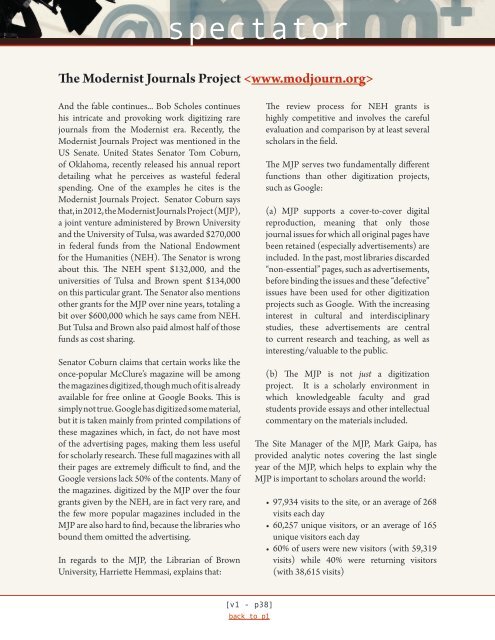Create successful ePaper yourself
Turn your PDF publications into a flip-book with our unique Google optimized e-Paper software.
spectator<br />
The Modernist Journals Project <br />
And the fable continues... Bob Scholes continues<br />
his intricate and provoking work digitizing rare<br />
journals from the Modernist era. Recently, the<br />
Modernist Journals Project was mentioned in the<br />
US Senate. United States Senator Tom Coburn,<br />
of Oklahoma, recently released his annual report<br />
detailing what he perceives as wasteful federal<br />
spending. One of the examples he cites is the<br />
Modernist Journals Project. Senator Coburn says<br />
that, in 2012, the Modernist Journals Project (MJP),<br />
a joint venture administered by <strong>Brown</strong> <strong>University</strong><br />
and the <strong>University</strong> of Tulsa, was awarded $270,000<br />
in federal funds from the National Endowment<br />
for the Humanities (NEH). The Senator is wrong<br />
about this. The NEH spent $132,000, and the<br />
universities of Tulsa and <strong>Brown</strong> spent $134,000<br />
on this particular grant. The Senator also mentions<br />
other grants for the MJP over nine years, totaling a<br />
bit over $600,000 which he says came from NEH.<br />
But Tulsa and <strong>Brown</strong> also paid almost half of those<br />
funds as cost sharing.<br />
Senator Coburn claims that certain works like the<br />
once-popular McClure’s magazine will be among<br />
the magazines digitized, though much of it is already<br />
available for free online at Google Books. This is<br />
simply not true. Google has digitized some material,<br />
but it is taken mainly from printed compilations of<br />
these magazines which, in fact, do not have most<br />
of the advertising pages, making them less useful<br />
for scholarly research. These full magazines with all<br />
their pages are extremely difficult to find, and the<br />
Google versions lack 50% of the contents. Many of<br />
the magazines. digitized by the MJP over the four<br />
grants given by the NEH, are in fact very rare, and<br />
the few more popular magazines included in the<br />
MJP are also hard to find, because the libraries who<br />
bound them omitted the advertising.<br />
In regards to the MJP, the Librarian of <strong>Brown</strong><br />
<strong>University</strong>, Harriette Hemmasi, explains that:<br />
The review process for NEH grants is<br />
highly competitive and involves the careful<br />
evaluation and comparison by at least several<br />
scholars in the field.<br />
The MJP serves two fundamentally different<br />
functions than other digitization projects,<br />
such as Google:<br />
(a) MJP supports a cover-to-cover digital<br />
reproduction, meaning that only those<br />
journal issues for which all original pages have<br />
been retained (especially advertisements) are<br />
included. In the past, most libraries discarded<br />
“non-essential” pages, such as advertisements,<br />
before binding the issues and these “defective”<br />
issues have been used for other digitization<br />
projects such as Google. With the increasing<br />
interest in cultural and interdisciplinary<br />
studies, these advertisements are central<br />
to current research and teaching, as well as<br />
interesting/valuable to the public.<br />
(b) The MJP is not just a digitization<br />
project. It is a scholarly environment in<br />
which knowledgeable faculty and grad<br />
students provide essays and other intellectual<br />
commentary on the materials included.<br />
The Site Manager of the MJP, Mark Gaipa, has<br />
provided analytic notes covering the last single<br />
year of the MJP, which helps to explain why the<br />
MJP is important to scholars around the world:<br />
• 97,934 visits to the site, or an average of 268<br />
visits each day<br />
• 60,257 unique visitors, or an average of 165<br />
unique visitors each day<br />
• 60% of users were new visitors (with 59,319<br />
visits) while 40% were returning visitors<br />
(with 38,615 visits)<br />
[v1 - p38]<br />
back to p1
















